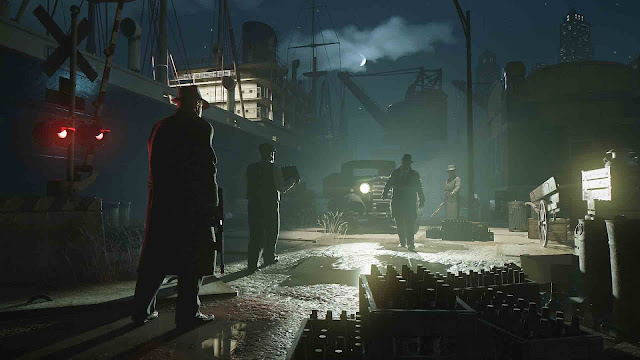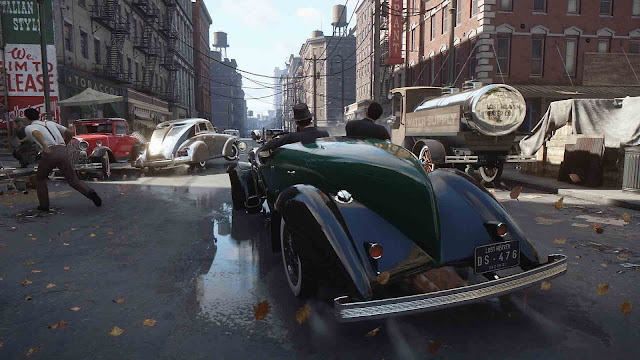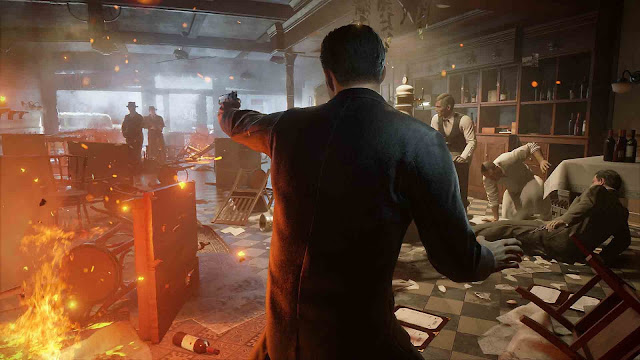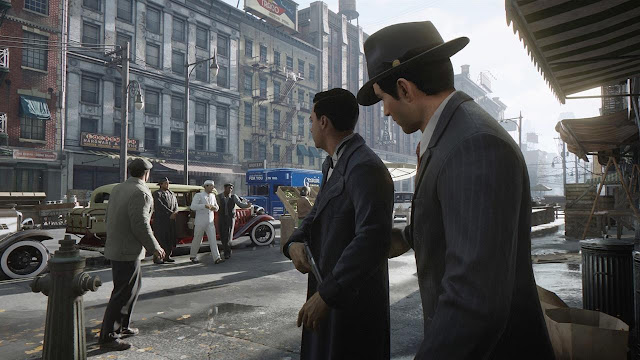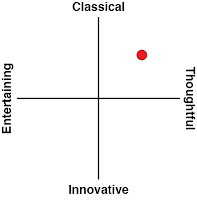As it did with Mafia 3, Hangar 13 trades gameplay for narrative in its remake of Mafia: The City of Lost Heaven, and the results are glorious. For those who were fans of the 2002 cult classic by Illusion Softworks (no, not that Illusion), Mafia: Definitive Edition takes the bones of the original plot and polishes it into one of the most impressive cinematic representations of crime in the gaming medium.
At its core, Mafia is about the push and pull of crime, and the moral conflicts which exist between loyalty to one’s family and the law. Refreshingly, the Mafia series revels in its moral ambiguity, setting itself apart from other open world titles like Saints Row which revel in the player’s villainy, or discard all questions of morality from the get-go like in Grand Theft Auto. Mafia, particularly Hangar 13’s Definitive Edition, is extremely interested in the inner workings of criminals, how they justify their actions, and whether the player sympathises or condemns the events. This is a game where crime pays, but at what cost?
Players take the role of Tommy Angelo, a low-class taxi driver in the city of Lost Heaven (a fictional amalgamation of New York, San Francisco and Chicago) caught in the grip of the Great Depression. In a brilliant sequence of early missions, we see him forced at gunpoint to escort two members of Salieri’s mob – Sam and Paulie – away from enforcers from a rival gang, thereby showing Angelo’s uncanny knack for getaway driving. The next day, the player watches as he drives taxi fares, obeys the speed limit, and is constantly denied respect and tips from snooty Americans who blame the Depression on migrants like Tommy not having “real jobs”. The shift ends with his car destroyed by an incensed rival gang member, and a hurried dash to Salieri’s headquarters, at which point Tommy slowly finds himself falling deeper and deeper into working for the local mob.
In contrast to the revenge tragedy of Hangar 13’s previous effort, Mafia 3, the first game in the series is all about the temptations of power, and how one action forces the hand of another. Angelo’s descent into the Salieri crime family is gradual and believable, translating nicely onto a sequence of driving and shooting missions of escalating difficulty. The underground war with the rival mob family, Morello, makes up most of the game’s plot, and sees Tommy evolving from a meek getaway driver to a respected sharpshooter. The missions are all taken 1:1 from the original 2002 game, and bring the player to various locales to show all the different expected faces of organised crime.
Whereas Mafia: The City of Lost Heaven was a proto-open world game, released to critical acclaim but only mild commercial success in between Grand Theft Auto 3 and Vice City, Mafia: Definitive Edition is split much more modally into an action-adventure based linear Story Mode, and a true-open world in Freeride mode, unlocked after the first mission. Story Mode is where Hangar 13 really show its strengths as a developer. Missions are choreographed tightly to maximise tense moments and keep players on the edge of their seat, and the refinements to the graphics, mechanics and quality of life ensure that the original game’s narrative comes across with far greater earnestness than before.
Special mention needs to be given to the facial capture and voice acting; whereas in the original game the script was stilted and the actors moreso, Definitive Edition’s actors feel like they’re embodying the true vision of what The City of Lost Heaven was meant to be. Even in 2002, Illusion Softworks were well ahead of their time in terms of narrative: they put story at the forefront of each of their missions, and maintained a small cast of characters who stay constant over the game’s runtime – building familiarity, attachment, and tragedy. Definitive Edition recognises this as the original game’s strength, and bends the design ethos around it. There are moments where I recognised the original game’s script being rewritten, sometimes quite dramatically, but the intended “feel” of the original mission or cutscene always stayed the same. Overall, the remake keeps the tone much more consistent, retains the golden one-liners, characters and plot twists that made the 2002 game great, but finds every opportunity to make that experience palatable for a modern player. Special mention needs to be given to the voice actors for Don Salieri and Paulie – both give absolutely phenomenal performances which sell the depth of their respective characters.
So the narrative comes out looking like the best version of the 2002 cult classic, and for that reason Hangar 13’s remake is a resounding success in my eyes. But for seasoned fans of the original game, there are some gameplay changes which might provoke dissent – though I am going to frame this aspect of the review as more of a justification for these mechanical changes. The original Mafia was a third person shooter reminiscent of design philosophies at the time. It featured big, wide, non-linear levels with enemies scattered across, forcing the player to make their own path to their destination. My best comparison is the early levels of Half Life: lots of space, intelligent enemies, danger from every direction. Mafia: Definitive Edition on the other hand is very stubbornly a cover shooter. Hangar 13 know how to play to their strengths, and so most of the gunfights from the original game have been adapted to be unidirectional, push-down-the-corridor affairs. There are pros and cons to this approach.
The benefit of being a cover shooter is that the player is kept in a state of tension at all times. They can see all their enemies right in front of them, and they’re compelled into a state of forward progress. There are no moments in Definitive Edition where the player can get lost or confused at what they need to do next, and it was precisely those moments in the 2002 game which forced players to a walkthrough, or to give up the game altogether. The fact that Mafia: Definitive Edition is a bog-standard cover shooter, also means that all players are equipped to see the narrative through to its end. The downside however is that cover shooting is an uninteresting gameplay mechanic, I’ll admit. There are less guns to play around with in Mafia: Definitive Edition compared to Mafia 3, and while the Thompson Submachine Gun is great mob-movie wish fulfillment, it does get dull over the course of long sessions. Furthermore, the game tends to fall apart if players don’t play in the intended cover shooter method – health is short and barely regenerates except for the very last sliver, and if enemies surround the player, a quick death is the reward. Long loading times also discourage trial-and-error gameplay, and although the Definitive Edition is more generous with checkpoints than the original, it’s also a lot less rewarding to players who want to take a more creative approach.
This design really speaks to both the strengths and weaknesses of Hangar 13’s house style. As with Mafia 3, for players who are interested in this game for the power fantasy of being a mobster, the shooting mechanics will come up lacking. Hangar 13 at no point seems interested in presenting a glorified, uncritical representation of crime for the sake of titillation. But the original Mafia was not a game solely about shooting, and Mafia: Definitive Edition decisively de-emphasises the gunplay in order to spend resources on narrative and worldbuilding. If you didn’t like the gunplay of Mafia 3, the only compliment I can give then to Mafia: Definitive Edition is that there’s less of it. Warehouse shootouts from the original game have largely been shortened, replaced with elongated setpiece moments which, in my opinion at least, are worth their weight in gold. For what it’s worth too, the included “Classic” difficulty mode retains the original’s harsher design featuring no mini-map, reduced ammo and no regenerating health. It does just mean that players need to be an absolute savant with their headshots though – probably better done on PC than on console. I tried it for a few missions before switching it down to Medium difficulty: I recommend whatever helps you finish the story at the most appropriate pace.
What is unquestionably fantastic in Mafia: Definitive Edition though is the driving. The 1930’s era cars look fantastic and handle and even crumple in believable ways. I actually rather appreciated the fact that the historical setting slows down the pace of the game – it creates time for characterisation while Tommy, Sam and Paulie converse in the drive across town for each mission, and it reduces the spectacle creep of fast cars, aeroplanes and quick-travel that recent open-world titles have spoilt us all on. Driving through the recreation of Lost Heaven is a treat – the period appropriate advertising, decorations and radio stations (there’s only two; one with news and one with hot jazz) are a wonderful distraction from our current world. Other drivers are surprisingly intelligent – they’ll move out of the way to your car horn, and you’ll see interesting little vignettes: breakdowns, accidents, pick-ups and drop-offs, occur organically as you explore the city.
Police are intelligent too: there is a wanted rating just like in GTA, but it’s more grounded. A single star can be incurred by colliding with another vehicle or, in “Realistic” mode, going over the speed limit in sight of a police officer. If a cop car starts blaring its horn at you, you can stop the vehicle at which point… you’ll get a speeding ticket (and there’s not even a money mechanic in this game, the ticket is purely for flavour). Putting other peoples’ lives at risk will encourage police to arrest you (a game over), and only killing others or police will make cops shoot on sight. Police can intelligently set up barricades to force players to get creative when evading them. Lost Heaven’s police department have remarkably short attention spans, possibly owing to the fact that they’ve been paid off by the two crime families to lay down the law lightly, so if the player manages to stay out of sight for a little while, they’ll lose the heat. Many missions in the game involve car chases with the cops, and it’s never a tedious affair as it can be in other open-world titles.
If the player wants a break from the narrative, they can try out the game’s Freeride mode, which features a number of side missions which have been cribbed from the 2002 game’s open world. This helps with narrative pacing greatly; Tommy Angelo in this edition never makes a detour from running Salieri’s errands in order to go chasing some fancy car he saw on the street. In Freeride mode the player finds letters throughout the Salieri establishment (it has multiple floors, by the way) and are led on a search throughout the city for unlockable exotic vehicles. Collectibles such as magazines, pulp fiction and postcards can be found in many key areas, and the postcards even lead the player to some hidden-in-plain-sight side content. I was a little disappointed though that the magazines are only covers; I felt like it was a missed opportunity to do some extra world-building by giving the player reading material, like Mafia 3 did. The cigarette cards which represent notorious mobsters does lend some cohesiveness to the trilogy though: figures appearing in Mafia 2 and 3 can be found as trading cards, with even a little bio on the back. While Freeride mode does appear empty at first, there’s a lot to discover for the inquisitive player who knows where to look. It is, however, not quite the bombastic journey that the story mode is, and it’s definitely a more zen-inspired open world than something flashy and violent like Far Cry or GTA.
Ultimately though, I just want to play the story mode over and over. The missions in Mafia: Definitive Edition are artfully made – they’re eventful, emotionally rich, and deeply fascinating in their representation of the human psyche. It’s the exact same appeal as watching a movie like The Godfather, and wondering just what the characters must be thinking as they hold a gun up to another man’s face. Mafia: Definitive Edition’s narrative means something. It forces players to critically assess the life and crimes of Tommy Angelo as he tells his story to a police informant. Do we, the player, forgive him? Do we understand him? Could the impulses which drove him to do what he did, also exist within us? These questions were in the original Mafia, buried beneath the complex gameplay and 2002 era production values – but in Definitive Edition, they’re right at the forefront, staring the player in the face. Hangar 13 have done an amazing job in modernising Mafia: The City of Lost Heaven into a truly powerful narrative experience, one which I hope that fans of the original will be pleasantly surprised by.
– Harvard L.
Contributor
The critic was provided with a copy of this game for review.


